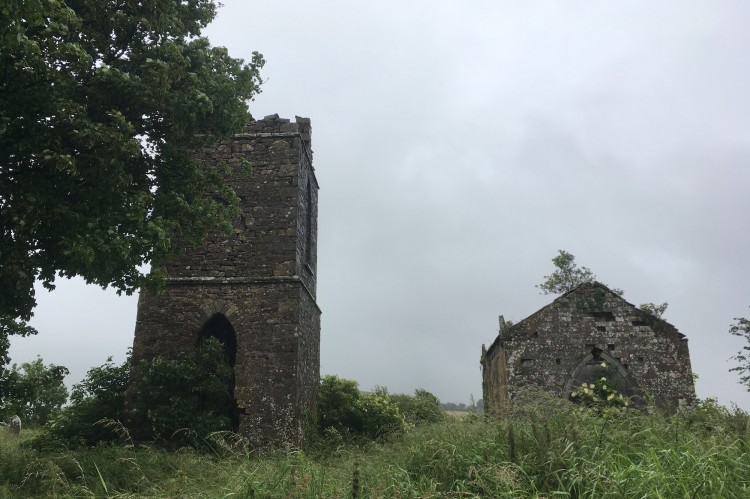Aug
02
2023
This graveyard lies west of Galbally, a village in southeast County Limerick, on the border with County Tipperary, at the foot of the Galtee Mountains. The Aherlow River flows southeast of the townland and Duntryleague Hill is immediately east. The village of Garryspillane lies to the west with the village of Ballylanders to the south.
Duntryleague graveyard is in the townland of Duntryleague, in the parish of Galbally and in the barony of Coshlea. The townland of Newtown lies to the west of Duntryleague townland and Deerpark townland to the east. Travelling south-east from Garryspillane village on the R663, take a left at the second fork in the road. The graveyard is located 1 km away.
The name Duntryleague is the anglicised version of Dun Tri Liag. Dun means Fort, Tri means three and Liag means stone or pillar-stone… the fort of the three pillar-stones, most likely referring to the nearby Duntryleague Passage tomb, also known as ‘Diarmuid and Grainne’s Bed’, located on Duntryleague Hill. According to Folklore the name has its origins in the story of Cormac Cas, King of Munster, injured in a battle against the king of Ulster, was laid to rest in a fort which was especially built for him. Three pillar-stones supported his bed, which was erected close to a spring. When he died he was buried in a cave within the fort, (Duchas.ie).
The graveyard is roughly rectangular in shape, 45m N-S x 56m E-W. It is enclosed by post-1700 rubble stone walls and the entrance is in the western wall and is marked by sandstone piers and a double-leafed gate, in poor condition. The graveyard has two focal points. Firstly, the remains of the Church of Ireland church, built c. 1750. Only the tower of the church is extant. It is square in plan and stepped in three stages, built in sandstone and limestone. Secondly, the Massy family burial place is marked by a free standing, gable-fronted mauseleum, dated to c. 1828. According to folklore, ‘Captain Massy who built the church…is buried under the floor of the church’ (Duchas.ie).
A total 16 memorials were recorded in a survey carried out in 2022 (Historic Graves.ie). Only nine memorials of the sixteen recorded were legible. The earliest memorial recorded was the box tomb marking the burial place of William Johnson who died in 1770, (memorial no. 007).
The following names were recorded; Bishop, Harding, Hare-Bowers, Franks, Massy, Massy-Bennett, Johnson and Maturin.
According to folklore, ‘Protestants attended Duntryleague Church many years ago for service. It is said that there was a row of four-wheeled carriages at each side of the church for a mile long on a Sunday morning’(www.duchas,ie.).
The story goes that the caretaker of Massy Lodge, Pat Burke died in 1886 and is buried in Duntryleague Graveyard. He was a famous storyteller. He was born in Oldtown, Bruff, (www.duchas.ie). His burial place was not identified during our survey.
Some members of the Bishop family are buried in Duntryleague. This family built the woollen mill in Galbally. Sheep farmers from the surrounding parishes of Galbally, Knocklong, Ballylanders, Aherlow and Emly brought their wool to this mill. However, by 1892 the Bishops became bankrupt and the mill was later taken over by the Phelan Family of Galbally, who for many years used it as a mill for crushing corn, and later still as a saw mill, (Duchas.ie).
Memorial no. 014 marks the burial place of Henry Bishop who died in 1828. His grave is commemorated with a recumbent slab. Memorial no. 012 marks the burial place of Alice Bishop who died in 1880. Both quite possibly related to John Bishop, the mill owner.
Thomas Franks of Ballyscadane was a Justice of the Peace and sat on the bench at Galbally, Hospital and Kilfinane Petty Sessions Courts in the 1880’s. His wife Elizabeth-Clara Franks who died in 1878, and his son who died in 1894 are buried in this graveyard, memorial no. 005.
As mentioned above, the earliest recorded burial in the Historic Graves survey is memorial no. 007, commemorating William Johnson who died in 1770. Is this the same William Johnson who married Francis Downing and lived in Lissard and had three children, Aphra, Samuel and William?
Interesting facts
The site of the fort of Duntryleague lies immediately to the east/north-east, in the adjacent field. This may also be the site of the medieval chapel, but there is little or no trace of it or the ringfort. St. Patrick’s well, also located in this field, is visible. A chapel is depicted on the 17th century Down Survey Map of the barony of Coshlea, where it is shown to be in the vicinity of the graveyard. Westropp (1905-6) records that ‘the graveyard exists near the ancient dun…The well is of St. Patrick’.
There is a pattern held at St. Patrick’s Well every year on the 17th March. According to folklore, St. Patrick spent a night in Duntryleague on his way from Cashel to Kilmurry (unspecified), (www.duchas.ie.).
The Bennett family owned nearby Gleneffy House which was built on the site of the older castle (also known as Castle Creagh). It is located on the hillside of the Glen of Aherlow, to the north of Galbally. William H Massey Bennett, a Justice of the Peace, was the last Bennett to live there. The house was sold in 1920. His parents are buried in the graveyard, (memorial no. 011). The headstone commemorates the death of his father William Henry Massy Bennett (senior), who was also a justice of the Peace, He died in 1880 aged 75 years. His mother Fanny Massy Bennett died in 1912 aged 67 years.
There is a place in western New South Wales in Australia called Duntryleague. In 1847 James Dalton, originally from Duntryleague, County Limerick, established a flourishing business in stores and mills in the small settlement of Orange. By 1872 he and his family had acquired many hundreds of acres. They built a residence on this land and named it Duntryleague after his birth place in Ireland. James lived here until his death in 1919. The property was left to his son Patrick Dalton, who was a Jesuit priest. Today the estate is a golf course.
18th Century memorials in Duntryleague Graveyard
007 William Johnson 1770
This post was researched and written as part of a grassroots heritage tourism project (www.incultum.eu) in collaboration with Ballyhoura Development CLG (https://www.ballyhouradevelopment.com/), Cork Co. Council (https://www.corkcoco.ie/en) and Limerick Co. Council (https://www.limerick.ie/council). The stories were initially gathered during a community survey of the graveyard. They form part of the Historic Graves Project Destination for Ballyhoura (https://historicgraves.com/destination/ballyhoura).



